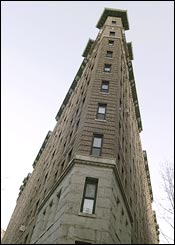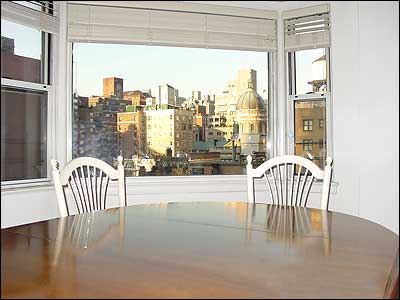
When Christian Kohn, an actor, and his fiancée, Laurie Churba, a costume designer for Saturday Night Live, decided to buy a place in March, they set the bar way low. They wanted out of their “roach-infested” East Village studio, and their budget hovered between $150,000 and $300,000. “We thought we’d end up in a warehouse in Red Hook a mile from the subway,” he says. Doormen, concierges, and crown moldings were out of the question.
Eight months later, they were unpacking in their 900-square-foot one-bedroom in River Arts, one of three premier co-ops in the Audubon Terrace section of Washington Heights (in the West 150s) and as graceful as anything on Park Avenue. The Kohns spent 30 percent less ($320,000) than they would’ve in a wealthier area.
It’s the usual fringe-neighborhood story—buyers choose a less-desirable location to get more for their money—but with a surprise. Most gentrifiers are reclaiming buildings that have slid into decay, whereas these downtown buyers found a surprising degree of elegance—in a neighborhood few upscale types visit unless their doctors work at Columbia-Presbyterian. Consider the Riviera, at Riverside Drive and 156th Street: Built in 1910 by Rouse and Goldstone (the architects behind 1107 Fifth Avenue), it has a double-height marble lobby and private storage rooms. “Except you’re not paying $3 million on Park Avenue,” says Jude Dayani, an agent at Orsid Realty who sold her 1,600-square-foot two-bedroom for just over $800,000 to Bob Bangiola, an arts administrator, and his partner, Fred Lake, a public-relations executive. “We found other apartments, but this was just more polished,” Bangiola says. The co-op boards are saner than on Park Avenue, too: “We don’t have that attitude around here,” says the Riviera’s board president, Vivian Ducat. Another such building is the Grinnell (pictured), sometimes called the “Dakota of the North,” whose 83 apartments have never been chopped up. Karen Sanford and Ann Ferguson of Klara Madlin recently sold a nine-room duplex there for $825,000. “Where else can you find space like that?” Sanford asks.
The drawback is, as in many less-affluent neighborhoods, a shortage of services. “I was concerned when we moved, because there were no good restaurants,” says Nina Skriloff, who manages international theater tours and who recently bought a two-bedroom in the Riviera with her husband after looking at no fewer than 175 apartments all over town. But the recent opening of a café gives her hope. “I ran into one of my neighbors, and he said, ‘Yay, panini!’ ”
Movers
A Photo Finish
Photography galleries have seen prices for Richard Avedon’s prints rise steadily over the years, and that’s sure to continue in the wake of his death in October. But the true collector may want to consider an even more lucrative investment: Avedon’s 7,000-square-foot carriage house at 407 East 75th Street, between First and York Avenues, was just put on the market for $6.75 million. Long heralded as one of the country’s most influential portrait and fashion photographers, Avedon lived in the building, which he bought in 1970, and shot many of his definitive portraits there. The managers of the estate say that they’d like to see it remain a studio, but that the equally justifiable wish to raise cash for the soon-to-be-established Richard Avedon Foundation may win out. “In a perfect world, we’d love it if another photographer or an arts organization buys it,” says Jed Garfield of Leslie J. Garfield & Co., which is managing the sale. Realistically, though, “unless it’s down to two competitive bids,” it’s going to the buyer with the most attractive offer. As so many of Avedon’s subjects—from Kissinger to Kerry—could tell you, power and money usually prevail.

Photo Credit: Donald Bowers for New York Magazine
Triple Assessment
174 East 74th Street
Two-bedroom, two-bath, 1,400-square-foot co-op.
Asking price: $1,299,000.
Monthly maintenance: $1,459 (includes cable TV).
Broker: Ryan Sherman, Century 21/William B. May.
Within two weeks of hitting the market, this apartment received one offer, which was refused by the sellers. Why? It was more than $100,000 below the asking. But that may be where it needs to be, as the agents on our panel suggested. Especially for a space that, although pretty and recently renovated, will still need more work.
Naomi Davis, Coldwell Banker Hunt Kennedy: “It’s got great closets and good light,” says Davis, but buyers may be unable to appreciate it because of the clutter and the furniture arrangement. “The space isn’t utilized to its full advantage.”
Her assessment: $1.15 million.
Samantha Kleier Forbes, Gumley Haft Kleier: The location, a stone’s throw from J.G. Melon and Scoop, is top-notch, and the split two-bedroom layout works well. But although the owners “obviously put a lot of money into the kitchen, at the end of the day, it’s still a galley kitchen. It’s claustrophobic.” Plus, she notes, the master bath has only a shower—no tub.
Her assessment: $1.175 million.
Marcos G. Cohen, Douglas Elliman: “The view from the bay window in the living room is charming,” says Cohen, “and the bones of the apartment are very good. But it’s still a postwar, and the kitchen isn’t to everyone’s taste.”
His assessment: $1.199 million.